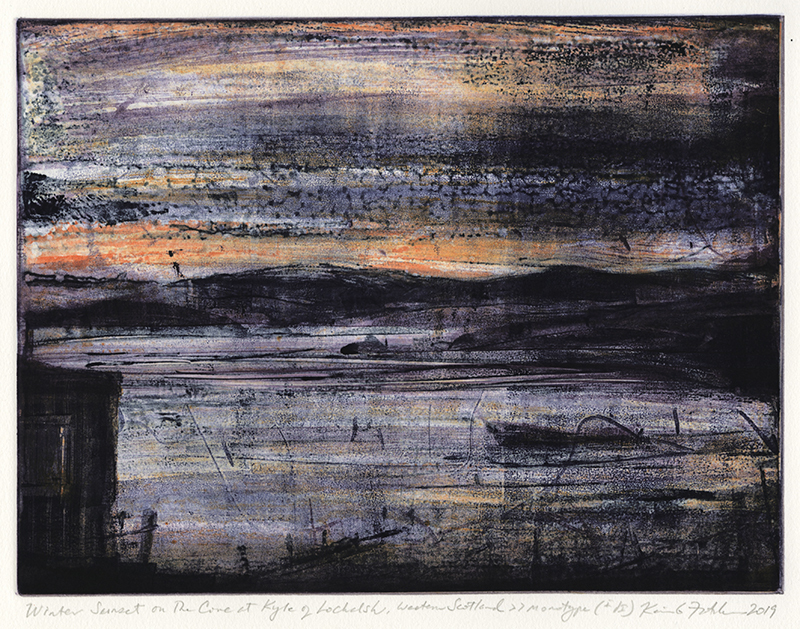
19th, 20th & 21st Century Fine Prints
707-546-7352 · fax 707-546-7924 · web: www.annexgalleries.com · email: artannex@aol.com
Winter Sunset on the Cove of Kyle of Lochalsh, Western Scotland by Kevin Fletcher

Winter Sunset on the Cove of Kyle of Lochalsh, Western Scotland
Kevin Fletcher
Winter Sunset on the Cove of Kyle of Lochalsh, Western Scotland
Kevin Fletcher
1956 - PRESENT (biography)Undiscovered Scotland notes: "Kyle is older than it looks and it is likely that there was a settlement here before 1600. In 1819 the road from Inverness arrived, via Lochcarron and a ferry across Loch Carron to Stromeferry before coming through Plockton. Kyle then rapidly became the main ferry terminus for Skye.
From 1897 when the Highland Railway from Inverness reached Kyle the town took over from Stromeferry the role of mainland terminus for the steamers to Stornoway as well. It was only the advent of the roll-on roll-off era in 1973 that saw the Stornoway ferries start to use the shorter crossing from Ullapool. Until 1995 the Skye ferries left from the slipway by the Lochalsh Hotel. Vehicles embarking here were carried across Kyle Akin (the strip of water separating Skye from the mainland) to the slipway opposite at Kyleakin.
That all changed with the opening of the Skye Bridge. The bridge brought many changes to Kyle. No longer do visitors have to put up with the ferry queues stretching back down the A87 in busy periods. And the building of a new road from the centre of Kyle to the bridge has opened up parts of the town that were previously largely inaccessible."
Fletcher's artistic background is broad, with inspiration and technique stemming from his experimental, Atelier 17-trained professors to the classical, representational stylings of Old Masters. His most well-known prints are black and white abstractions suggestive of architectural ruins and dark, wintery landscapes, achieved through reductive methods; however he is also a classically trained painter. After many years of separating his reductive (relief print) and additive (painting) techniques, he decided to try to combine these modes on the matrix.
Said Fletcher of his latest work: "What I wanted in color prints was a painterly way - like with litho - adding layers of drawn color in gradual accumulation, or even rapid accretion if it suggested this in process. So, multiple over-printings like lithography - or, multiple roller pass on the same plexiglass to paint with the roller/brayer, feathering in and out, as needed. Moreover, I wanted to find a way to make a positive mark like a pencil - a colored pencil - like the litho crayon, which is printed from the stone (or plate). I reasoned that since I was already using a cardboard/matboard chip and [was] used to it, I should try that out somehow.
"It occurred to me that if I started from solvent, applied with a fine cotton cloth, I could cut through that sheen with a tip or corner of the chip - in the same way I had in my reductive work. This had always afforded calligraphic white lines in those dark B&W prints. If the chip would expose the plexiglass, why wouldn't an oil based ink TAKE to those exposed areas? Well, with the right oil added - it did.
"Then, the roller could be set up in the 'split fountain roll' - a blend, or further marks made, oil shifted and a different, darker pigment added, then rolled again. The only issue was 'lap marks' - roller circumference. But even that lap mark variation seemed to add an atmospheric interference. You can see how the open experimentation has played out. The vertical format means less obvious methodology."
